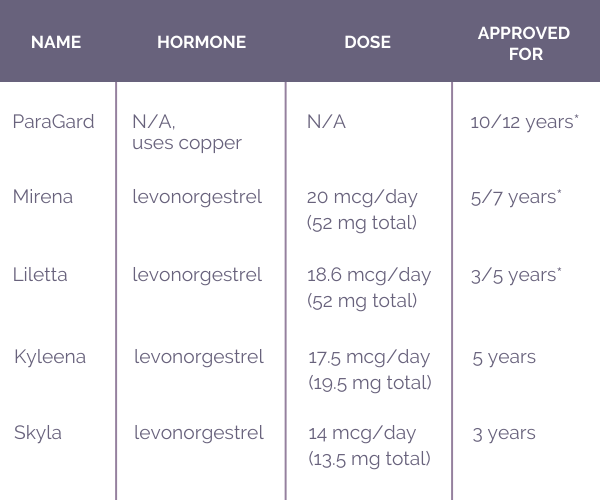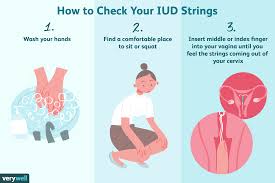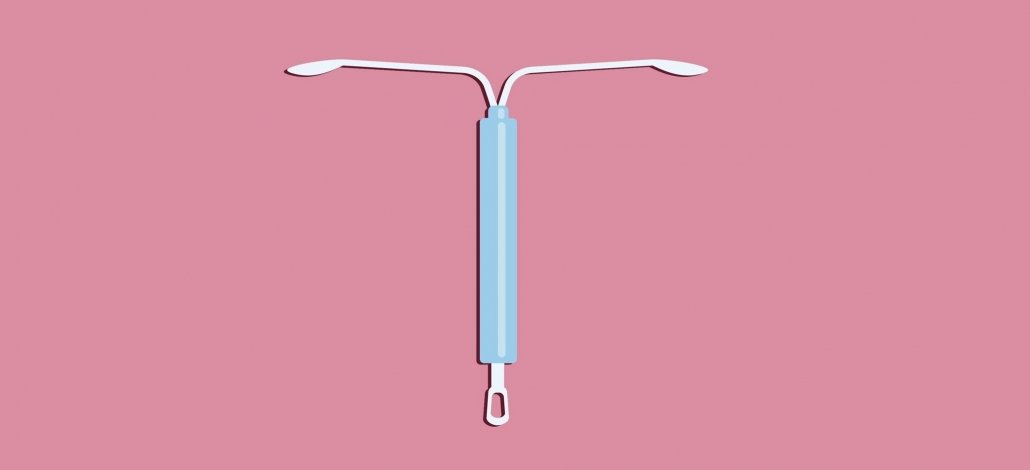Fast Facts
- IUDs have over a 99% success rate at preventing unwanted pregnancy
- IUDs are low-maintenance and long-term. No pills to take or shots to remember. Depending on the type of IUD you choose, an IUD can be effective for 3-10 years.
- They are reversible, after removal you should return to your normal cycle within a short amount of time.
- When placed properly, IUDs can not be felt by you or your sexual partner.
- They are safe to use while breastfeeding and can be placed immediately after delivery.
The Basics
An IUD (Intrauterine Device) is a small T-shaped device that takes about five minutes to place inside your uterus. There are two types of IUDs: hormonal and copper (non-hormonal).
- Thickening your cervical mucus so the sperm can’t reach the egg.
- Making your uterus a hostile environment for sperm and eggs, impairing any chance of implantation by inhibiting the sperm’s ability to swim toward the egg.
- Thinning out the inner lining of the uterus, impairing implantation, and also giving you lighter periods (or sometimes no period at all).
➤ Copper IUDs are a hormone-free option that work by releasing copper ions into your uterus. This makes your uterus a hostile environment for sperm and eggs, impairing any chance of implantation by inhibiting the sperm’s ability to swim toward the egg.
Patients should speak with their provider about which type may work best for them. IUDs do not protect against sexually transmitted infections or HIV/AIDS.

Scheduling An Appointment
Once you’ve decided on which IUD you’d like to try or if you have more questions, click here to schedule an appointment or call the Patient Support Center at (618) 997-5266, some things to keep in mind:
- It is best to have the IUD placed while on your period. This ensures that you are not pregnant, and can make insertion less uncomfortable.
- Choose a day that you don’t need to be your best (work, school, exam, travel) so you can recover at your own pace following insertion.
- Plan to be at the appointment for 1 to 1 ½ hours, including recovery time following the insertion.
Before The Appointment
- Continue using your current method of birth control until the IUD is inserted
- If you are not currently using any forms of birth control, please abstain from unprotected intercourse for at least 14 days prior to your IUD insertion appointment.
- Take 600mg ibuprofen (if allergy to ibuprofen or unable to take NSAIDs, take 1000mg Tylenol) 45 minutes before your appointment. Take this medication with food. This will help prevent some cramping and discomfort that comes with an IUD insertion.
During The Appointment
- You will be asked to leave a urine sample for a routine pregnancy test at the beginning of the appointment.
- It is common to experience cramping during the procedure. Pre-medication, relaxation techniques, and deep breathing will help.
- Your provider will talk you through the steps of the IUD insertion to help you feel prepared and comfortable.
After The Insertion
- You remain in the office for a brief recovery period. Your provider may check for proper placement after insertion using an intrauterine ultrasound.
- You may experience intermittent menstrual-like cramping and light spotting. There may be irregular bleeding for the first few days to weeks after the procedure. As discussed with your provider, you may have irregular bleeding for up to 6 months. Depending on which device you chose, your period will then likely become light and possibly go away or will establish a monthly pattern.
- You will need to schedule a follow-up appointment 4-6 weeks after insertion for an ultrasound and pelvic exam.
- If you experience bleeding heavier than a regular period, or persistent cramping, please call the Patient Support Center to speak with a nurse. (618) 997-5266
Self-Care At Home
- Recovery can take a few days to a few weeks, most patients experience moderate-heavy bleeding and cramping following insertion.
- You can take 600mg ibuprofen (Motrin, Advil), acetaminophen (Tylenol), or naproxen (Aleve) as needed, following package instructions for use.
- You can also use a heating pad or warm water bottle for cramping relief.
- Do not insert anything into the vagina for 24 hours (tampon, douche, intercourse).
What To Watch For
- Call the Patient Support Center at (618) 997-5266 if you:
- Develop a fever over 100.4֯ F.
- Have pelvic pain that is not getting better with medication or worsening.
- Severe vaginal bleeding (soaking through a pad or tampon every 1-2 hours),
- Feel dizzy/lightheaded.
- If you suspect the IUD is expelled or out of place. (It is recommended you use alternate birth control methods until you can be seen by a provider.)
Checking your “strings.” What the heck does that mean?
- IUD strings are short, plastic strings that your provider will ultimately use to remove your IUD. They also help you to check at home that your IUD is still properly placed. Your provider will explain to you about regular string checks; here are some things to keep in mind:
- Using clean hands, insert your finger into the vagina, and feel for your cervix. (Generally speaking, your cervix will feel firmer than the rest of your vagina and can have a smooth or rubbery texture.)
- You should feel two small soft strings coming out of the cervix when placed correctly.
- If you do not feel your strings, DON’T PANIC! The strings can move and curl around the cervix, which sometimes makes them difficult to find. Wait and try again later.
- If you have tried multiple times and/or suspect that your IUD has moved, call the Patient Support Center at (618) 997-5266. A provider should check for proper placement as soon as possible and an alternate form of birth control should be used until you can be seen.


